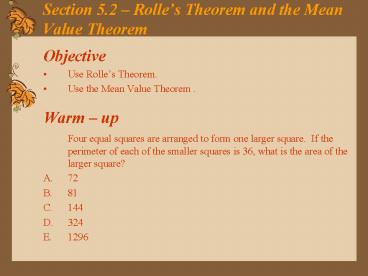Section 5.2 - PowerPoint PPT Presentation
1 / 6
Title: Section 5.2
1
Section 5.2 Rolles Theorem and the Mean Value
Theorem
- Objective
- Use Rolles Theorem.
- Use the Mean Value Theorem .
- Warm up
- Four equal squares are arranged to form one
larger square. If the perimeter of each of the
smaller squares is 36, what is the area of the
larger square? - 72
- 81
- 144
- 324
- 1296
2
Rolles Theorem
- Let f be continuous on the closed interval a,
b and differentiable on the open interval (a, b)
if f(a) f(b) then there is at least one number
c in (a, b) such that f(c) 0. - This theorem guarantees extrema in the interior
of a, b. - c the horizontal tangent line
3
Example
- Find the 2 x intercepts of
- Show that f(x) 0 at some point between the 2
intercepts. - Set f(x) 0
- Solve for x
- Check to see if the function is continuous on the
interval. - Differentiate
- Solve for x.
- Pick value that lies in between the two
intercepts.
4
Mean Value Theorem
- If f is continuous on a, b and differentiable
on (a, b) then there exists a number c in (a, b)
such that - Refers to a value where the average rate of
change is equal to the instantaneous rate of
change in a, b.
5
Examples
- Use the Mean Value Theorem to find c in -2, 1
of the function - Plug into MVT formula.
- Differentiate function.
- Set derivative equal to the value found with the
MVT formula. - Solve for c.
6
Class work and Homework
- Class work is p. 326 8, 14, 22, 24, 26, 28
- Homework is p. 326 7, 13, 21, 23, 25

